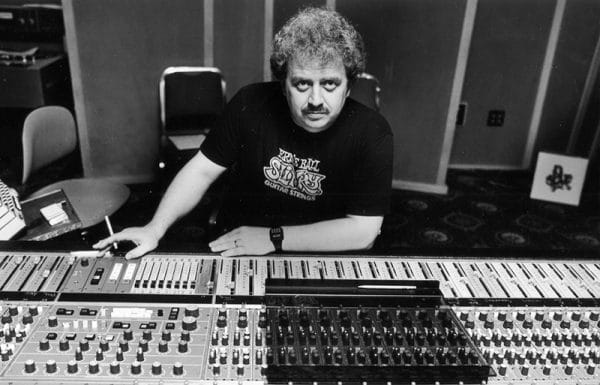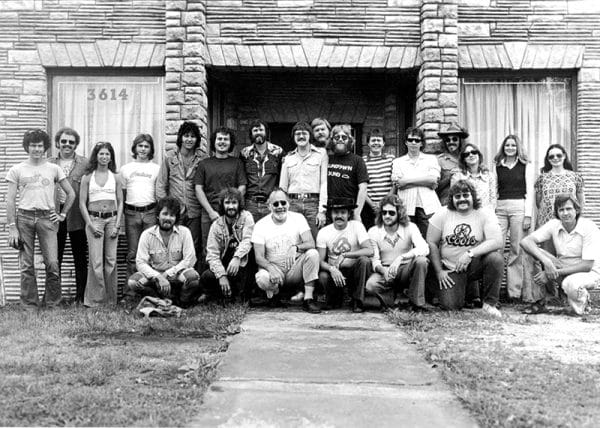Jimmy Ray Johnson
 Jimmy Johnson
Jimmy Johnson (1943-2019) of Sheffield, Colbert County, enjoyed a remarkable and extensive career as guitarist, recording engineer, and publishing powerhouse. A founding member of the Muscle Shoals Rhythm Section (MSRS), Johnson was a driving force behind the growth of homegrown music in his northwest Alabama. Moreover, his creative drive to establish a recording capital in Sheffield resulted in an impressive legacy of southern “soul” American music that earned international recognition. Furthermore, Johnson was, with MSRS drummer Roger Hawkins, the originator of Muscle Shoals Sound Studio (MSSS), founded in 1969 in Sheffield.
Jimmy Johnson
Jimmy Johnson (1943-2019) of Sheffield, Colbert County, enjoyed a remarkable and extensive career as guitarist, recording engineer, and publishing powerhouse. A founding member of the Muscle Shoals Rhythm Section (MSRS), Johnson was a driving force behind the growth of homegrown music in his northwest Alabama. Moreover, his creative drive to establish a recording capital in Sheffield resulted in an impressive legacy of southern “soul” American music that earned international recognition. Furthermore, Johnson was, with MSRS drummer Roger Hawkins, the originator of Muscle Shoals Sound Studio (MSSS), founded in 1969 in Sheffield.
Johnson was born on February 4, 1943, to Ray and Hazel (Roberson) Johnson; he had a brother, Earl Dean Johnson, who died in a Southern Airways plane crash in 1977. His father worked in the Muscle Shoals Reynolds Aluminum Plant. His youthful musical experiences were formative. His father was an amateur musician and his uncle Dexter Johnson built the first recording studio in Sheffield in 1951. The studio would be the place where Johnson had his first exposure to the art of music recording. Johnson was a member of a local band, Hollis Dixon and the Keynotes, and introduced him to the emerging rock & roll style that drew upon artists such as Elvis Presley, who performed in Sheffield in 1955. In addition, his discovery of music by black artists, particularly guitarists Chuck Berry and Bo Diddley, via Nashville’s WLAC radio, set the musical direction his career would take. Johnson graduated from Sheffield High School in 1961. Afterward, he served in the Alabama National Guard for six months of active duty. He then attended Florence State College (present-day University of North Alabama) but did not graduate.
In the early 1960s, Johnson and Roger Hawkins formed the Del Rays, a combo that played the college circuit across the South. After producer Rick Hall formed FAME Studios in Muscle Shoals in 1961. Johnson became Hall’s first employee. He learned the basics of session playing, publishing, and recording under the tutelage of FAME’s first house studio band, particularly guitarist Terry Thompson.
By 1964, FAME’s studio band had moved to Nashville for more lucrative work and Johnson was called upon to play recording sessions as a guitarist at FAME. In the meantime, Johnson had already begun playing and engineering sessions at Quin Ivy’s Norala Studio in Sheffield, where he engineered Colbert County native Percy Sledge‘s iconic classic “When a Man Loves a Woman” in early 1966. The song was the first gold record produced and recorded in Sheffield and established Muscle Shoals as a center for “southern soul,” a racially integrated musical form blending white country and African American rhythm & blues. Sledge’s hit propelled a budding relationship between FAME Studios and Atlantic Records producer Jerry Wexler. He brought soul singer and Autauga County native Wilson Pickett to FAME in 1966 to record future hits “Land of 1,000 Dances” and “Mustang Sally.” Photographic evidence shows Johnson, his Gretsch Chet Atkins (model 6120) guitar in hand, at FAME during this time. Then, in early 1967 Wexler produced Aretha Franklin’s first Atlantic Records single at FAME, “I Never Loved a Man (the Way I Loved You).” After tensions developed between Franklin’s husband and the recording staff, Wexler discontinued the session at FAME and instead brought Johnson, Hawkins, and the other session players to New York, where they recorded Franklin’s signature cover of Otis Redding’s “Respect.” An important outcome of Atlantic’s decision to bring Muscle Shoals players to New York was the emergence of the MSRS and the creation of the “Muscle Shoals Sound.”
 Muscle Shoals Sound Studio
Johnson and Hawkins, joined by bassist David Hood and keyboardist Barry Beckett, established in April 1969 the MSRS, a recording magnet that included a round-the-clock recording schedule, songwriting and publishing, and a remarkable level of production autonomy. The MSRS quickly became more deeply involved in creating and recording music with leading artists such as Arthur Conley, Rod Stewart, Linda Ronstadt, James Brown, the Staple Singers, Johnnie Taylor, Percy Sledge, Boz Scaggs, Lulu, Cher, Jimmy Cliff, and R.B. Greaves. In many sessions, Johnson played the dual role of musician and engineer. And as a budding music producer, Johnson had worked with The Tams, The Gants, and Bobby Moore and the Rhythm Aces in collaboration with Chicago’s Chess Records. This relationship prompted Etta James to visit Muscle Shoals in 1967 to record “Tell Mama.” When the Rolling Stones visited Muscle Shoals Sound to record “Brown Sugar” and “Wild Horses” in December 1969, Johnson was at the mixing board to engineer the basic tracks.
Muscle Shoals Sound Studio
Johnson and Hawkins, joined by bassist David Hood and keyboardist Barry Beckett, established in April 1969 the MSRS, a recording magnet that included a round-the-clock recording schedule, songwriting and publishing, and a remarkable level of production autonomy. The MSRS quickly became more deeply involved in creating and recording music with leading artists such as Arthur Conley, Rod Stewart, Linda Ronstadt, James Brown, the Staple Singers, Johnnie Taylor, Percy Sledge, Boz Scaggs, Lulu, Cher, Jimmy Cliff, and R.B. Greaves. In many sessions, Johnson played the dual role of musician and engineer. And as a budding music producer, Johnson had worked with The Tams, The Gants, and Bobby Moore and the Rhythm Aces in collaboration with Chicago’s Chess Records. This relationship prompted Etta James to visit Muscle Shoals in 1967 to record “Tell Mama.” When the Rolling Stones visited Muscle Shoals Sound to record “Brown Sugar” and “Wild Horses” in December 1969, Johnson was at the mixing board to engineer the basic tracks.
Johnson later toured Europe with Steve Winwood and Traffic in 1973, contributing to engineering duties. Sharing production credits between among artists and the MSRS became a standard practice. Notably, when Paul Simon recorded his album There Goes Rhymin’ Simon at Muscle Shoals Sound in 1973, he gave equal billing to the MSRS. Furthermore, Johnson had become the principle publishing supervisor for Muscle Shoals Sound Publishing Co., an arm of the business that had several dozen contracted songwriters in house, including George Jackson. Bobby Womack’s Home Is Where the Heart Is (1976), a project boasting shared production credits with the MSRS, exemplifies the level of collaboration at play.
At Muscle Shoals Sound Studio, Johnson produced sessions for Lynyrd Skynyrd in 1971-72 that were eventually released in 1978 on the album Skynyrd’s First and . . . Last. Johnson also produced Muscle Shoals guitarist Eddie Hinton‘s Letters from Mississippi album in 1982. Bob Seger, with whom the MSRS recorded several albums, became interested in Johnson’s 1978 demo production of “Old Time Rock and Roll,” which Seger later recorded. The song was popularized in an iconic scene in the 1983 film Risky Business, starring Tom Cruise and Rebecca De Mornay and has remained a commercial favorite since.
Johnson’s career continued throughout the remainder of the twentieth century. Along with the other members of the MSRS, he oversaw the renovation of the former National Guard Armory building at 1000 Alabama Avenue in Sheffield as the new state-of-the-art home of Muscle Shoals Sound, which was in business during the period from 1978-2003 (Malaco Records purchased the studio in 1985). Johnson’s producing and publishing talents led to the formation of Muscle Shoals Sound Records (in business from approximately 1980-2000), an affiliate of Capitol Records (and later Malaco Records). Johnson subsequently created Swamper Sound across the street from his uncle Dexter’s original studio in Sheffield. In 1995, as a member of the Muscle Shoals Rhythm Section, Johnson was inducted into the Alabama Music Hall of Fame. His Fender Telecaster guitar is on display at Cleveland’s Rock and Roll Hall of Fame.
Johnson died of complications related to kidney failure in Florence on September 5, 2019. He was buried in Oakwood Cemetery in Sheffield. Johnson was married three times and had two children from an early marriage. His last marriage was later in life to Becky Countiss, whom he had known since high school. Music fans remember Johnson for his incisive rhythm guitar work and funky solo fills that enhance hundreds of hit records made in Sheffield and Muscle Shoals. His intuitive sense for musical quality, that became known as “the Muscle Shoals sound,” helped earn Muscle Shoals international renown.
Additional Resources
Hoskyns, Barney. Say It One Time for the Brokenhearted: Country Soul in the American South. London: BMG Books, 1988.
Hughes, Charles L. Country Soul: Making Music and Making Race in the American South. Chapel Hill: University of North Carolina Press, 2015.
Reali, Christopher M. Making Music in Muscle Shoals. Chapel Hill: University of North Carolina Press, 2014.
———. “Helping Pave the Road to FAME: Behind the Music of Muscle Shoals.” Southern Cultures 21 (Fall 2015): 53-74.
Whitley, Carla Jean. Muscle Shoals Sound Studio: How the Swampers Changed American Music. Charleston, S.C.: Arcadia Publishing, 2014.



